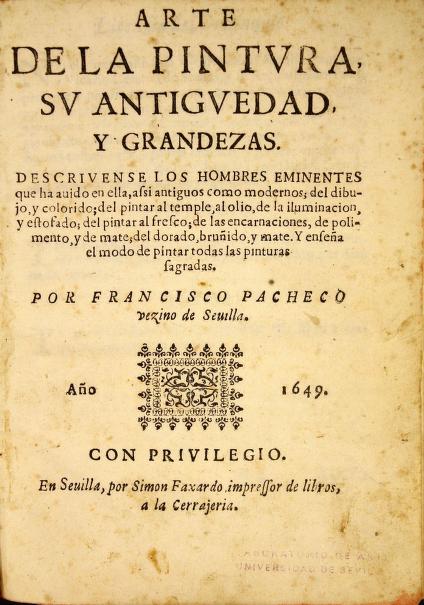
Frostispiece of Pacheco, El Arte de la pintura (1649), Seville, Simon Faxardo, impressor de libros, a la Cerrajeria
According to Pacheco, from an analysis made by Molanus, an erroneous, dangerous, and heretical manner of representing the Annunciation is, instead of depicting the Holy Spirit, adding a glow on the head of the Virgin, and in it a naked Child Jesus, with a cross on his shoulder, and the angels with God, the Father.
“but the one who walked boldly is the author of an image, without a name, which will be known by a place in Scripture at the bottom, which reads as follows: Suscitabu David germen iustum (Jerem. 23), which, instead of the Holy Spirit (which is so evident in this passage) put a glow on the head of the Virgin, and in it a naked Child Jesus, with a cross on his shoulder, and a glory of angels with God the Father, which painting, is not only an occasion for error, dangerous, but heretical, as Molanus warned because he conforms to the opinion of Valentino and his henchmen, whom the holy Church has condemned for many years as a heretic because he taught that Christ, our Lord, brought the body from heaven, and, for this, St. Antoninus reprimands with rigorously this painting, because it is of faith that the Holy Spirit formed the body of Christ our Lord from the substance of the Most Holy Virgin, in her most pure entrails”.
“pero quien anduvo atrevido es el autor de una estampa, sin nombre, que se conocerá por un lugar de Escritura que tiene al pie, que dice así: Suscitabu David germen iustum (Jerem. 23), que, en lugar del Espíritu Santo (que es tan forzoso en este paso) puso un resplandor sobre la cabeza de la Virgen, y en él un Niño Jesús desnudo, con una cruz sobre el hombro, y una gloria de ángeles con Dios Padre, la cual pintura, no sólo es ocasión de error, peligroso, pero herético, como advirtió Molano, porque se conforma con el parecer de Valentino y sus secuaces a quien la Iglesia santa ha muchos años que condenó por hereje, porque enseñó que Cristo, nuestro Señor, traxo el cuerpo del cielo, y, por esto, San Antonino reprehende con rigor esta pintura, porque es de fe que el Espíritu Santo formó el cuerpo de Cristo nuestro Señor de la sustancia de la sacratisima Virgen, en sus purisimas entrañas”.
Pacheco 1990, 594, n.15;



